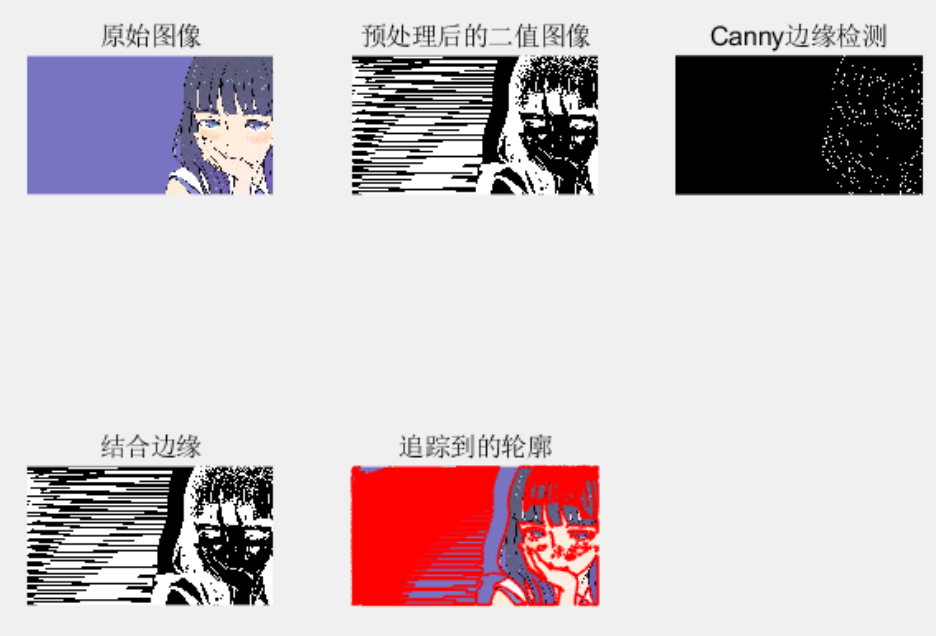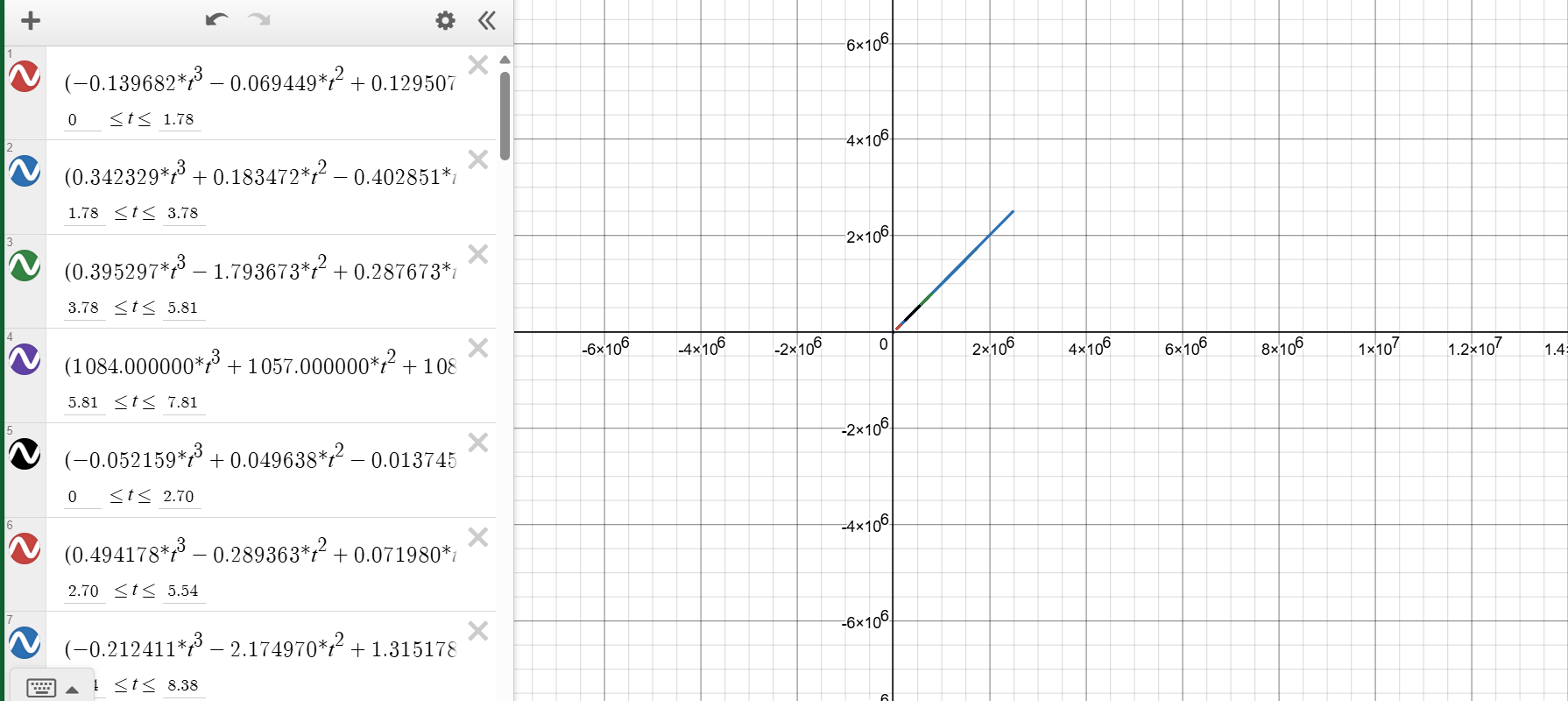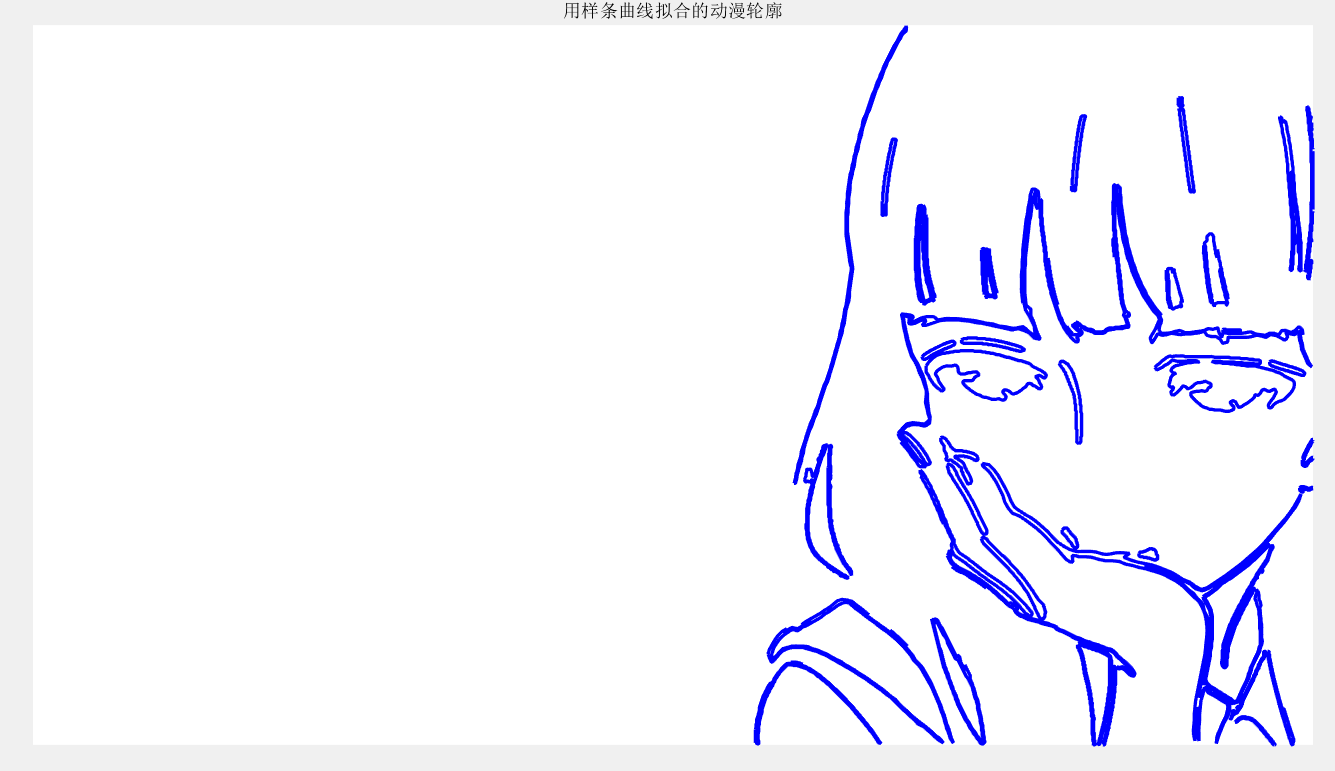前言
之前有看到B站上的up主进行人工拟合,然后看到有评论说用MATLAB进行拟合的,就用deepseek生成了一下,只能说费时费力的感觉,一个是对于精度高的图像拟合效果特别差(大家可以用自己的证件照试一下),就比如用ai进行模糊照片的优化,他可以增加图片的像素点,但可能出现的结果不像自己;另一个只能识别轮廓,对于不同的图片还需要调试显示的阈值,之前就出现过把纯色背景也出现线条的,而用动漫图片进行处理,可能就是结果也不是很像。

而且对于生成的函数还不知道如何导入desmos,他虽然生成了一堆函数,但是我还不知道如何使用,自己试了十多分钟发现结果近似一条直线。
example | Desmos![]() https://www.desmos.com/calculator/h2wsnoy3xi不知道是不是下面的这种方法,我是(x(t),y(t)),t的范围这样的形式,感觉不太对。
https://www.desmos.com/calculator/h2wsnoy3xi不知道是不是下面的这种方法,我是(x(t),y(t)),t的范围这样的形式,感觉不太对。

使用Python语言进行函数作画绘制芙莉莲&勇者-CSDN博客![]() https://blog.csdn.net/weixin_64066303/article/details/148412637?spm=1001.2014.3001.5501使用Python进行函数作画-CSDN博客
https://blog.csdn.net/weixin_64066303/article/details/148412637?spm=1001.2014.3001.5501使用Python进行函数作画-CSDN博客![]() https://blog.csdn.net/weixin_64066303/article/details/148383559?spm=1001.2014.3001.5501形态学图像处理_形态学图像处理python-CSDN博客
https://blog.csdn.net/weixin_64066303/article/details/148383559?spm=1001.2014.3001.5501形态学图像处理_形态学图像处理python-CSDN博客![]() https://blog.csdn.net/weixin_64066303/article/details/138317780?ops_request_misc=%257B%2522request%255Fid%2522%253A%25229d7c4289359b3d8883f431656d0460a1%2522%252C%2522scm%2522%253A%252220140713.130102334.pc%255Fblog.%2522%257D&request_id=9d7c4289359b3d8883f431656d0460a1&biz_id=0&utm_medium=distribute.pc_search_result.none-task-blog-2~blog~first_rank_ecpm_v1~rank_v31_ecpm-2-138317780-null-null.nonecase&utm_term=%E8%BD%AE%E5%BB%93&spm=1018.2226.3001.4450Canny算子-CSDN博客
https://blog.csdn.net/weixin_64066303/article/details/138317780?ops_request_misc=%257B%2522request%255Fid%2522%253A%25229d7c4289359b3d8883f431656d0460a1%2522%252C%2522scm%2522%253A%252220140713.130102334.pc%255Fblog.%2522%257D&request_id=9d7c4289359b3d8883f431656d0460a1&biz_id=0&utm_medium=distribute.pc_search_result.none-task-blog-2~blog~first_rank_ecpm_v1~rank_v31_ecpm-2-138317780-null-null.nonecase&utm_term=%E8%BD%AE%E5%BB%93&spm=1018.2226.3001.4450Canny算子-CSDN博客![]() https://blog.csdn.net/weixin_64066303/article/details/139259820?ops_request_misc=%257B%2522request%255Fid%2522%253A%2522128e956ccfd1321812df3ab3036e6f90%2522%252C%2522scm%2522%253A%252220140713.130102334.pc%255Fblog.%2522%257D&request_id=128e956ccfd1321812df3ab3036e6f90&biz_id=0&utm_medium=distribute.pc_search_result.none-task-blog-2~blog~first_rank_ecpm_v1~rank_v31_ecpm-1-139259820-null-null.nonecase&utm_term=%E7%AE%97%E5%AD%90&spm=1018.2226.3001.4450
https://blog.csdn.net/weixin_64066303/article/details/139259820?ops_request_misc=%257B%2522request%255Fid%2522%253A%2522128e956ccfd1321812df3ab3036e6f90%2522%252C%2522scm%2522%253A%252220140713.130102334.pc%255Fblog.%2522%257D&request_id=128e956ccfd1321812df3ab3036e6f90&biz_id=0&utm_medium=distribute.pc_search_result.none-task-blog-2~blog~first_rank_ecpm_v1~rank_v31_ecpm-1-139259820-null-null.nonecase&utm_term=%E7%AE%97%E5%AD%90&spm=1018.2226.3001.4450
代码
% 清除工作区和关闭所有图形窗口
clear; close all; clc;
%% 1. 图像读取与高级预处理
imageName = 'example.png'; % 图片文件名
[~, name, ~] = fileparts(imageName); % 提取不带扩展名的文件名
originalImg = imread(imageName);
figure;
subplot(2,3,1); imshow(originalImg); title('原始图像');
% 转换为灰度图
grayImg = rgb2gray(originalImg);
% 增强图像对比度以提高边缘检测效果
grayImg = imadjust(grayImg);
% 使用高斯滤波减少噪声
grayImg = imgaussfilt(grayImg, 1.5);
% 使用多种方法结合进行二值化
% 方法1: Otsu's 方法
level_otsu = graythresh(grayImg);
bw_otsu = imbinarize(grayImg, level_otsu);
% 方法2: 自适应阈值
bw_adaptive = imbinarize(grayImg, 'adaptive', 'Sensitivity', 0.5);
% 结合两种方法
bwImg = bw_adaptive | bw_otsu;
% 使用形态学操作清理图像
% 先去除小对象(噪声)
min_object_size = 100; % 增加最小对象大小
bwImg = bwareaopen(bwImg, min_object_size);
% 填充小孔洞
bwImg = imfill(bwImg, 'holes');
% 使用开运算平滑边缘
se = strel('disk', 3);
bwImg = imopen(bwImg, se);
% 使用闭运算连接断开的边缘
se = strel('disk', 2);
bwImg = imclose(bwImg, se);
subplot(2,3,2); imshow(bwImg); title('优化后的二值图像');
%% 2. 高级边缘检测
% 使用多尺度边缘检测
edgeImg1 = edge(grayImg, 'canny', [0.05 0.2], 1.0); % 细边缘
edgeImg2 = edge(grayImg, 'canny', [0.1 0.3], 2.0); % 粗边缘
% 结合多尺度边缘
edgeImg = edgeImg1 | edgeImg2;
% 使用Sobel算子增强边缘检测
sobelImg = edge(grayImg, 'sobel', 0.05);
edgeImg = edgeImg | sobelImg;
% 清理边缘图像
edgeImg = bwareaopen(edgeImg, 20); % 去除小边缘
edgeImg = imdilate(edgeImg, strel('disk', 1)); % 稍微膨胀边缘
subplot(2,3,3); imshow(edgeImg); title('多尺度边缘检测');
% 结合二值图像和边缘图像
combinedEdges = edgeImg;
% 只保留在二值图像中存在的边缘区域
combinedEdges = combinedEdges & imdilate(bwImg, strel('disk', 5));
subplot(2,3,4); imshow(combinedEdges); title('结合边缘');
%% 3. 轮廓追踪
% 填充小孔洞,使轮廓更完整
filledEdges = imfill(combinedEdges, 'holes');
% 使用bwboundaries追踪轮廓
B = bwboundaries(filledEdges, 'noholes');
% 可视化轮廓
subplot(2,3,5); imshow(originalImg);
hold on;
for k = 1:length(B)
boundary = B{k};
% 只绘制足够长的轮廓
if size(boundary, 1) > 50
plot(boundary(:,2), boundary(:,1), 'r', 'LineWidth', 1);
end
end
title('追踪到的轮廓');
hold off;
%% 4. 智能关键点提取
simplifiedBoundaries = cell(size(B));
tolerance = 0.8; % 增加简化容差,减少关键点数量
for k = 1:length(B)
boundary = B{k};
% 只处理足够长的轮廓
if size(boundary, 1) < 50
simplifiedBoundaries{k} = [];
continue;
end
% 使用Ramer-Douglas-Peucker算法简化轮廓
% 这里实现一个简化版本
if size(boundary, 1) > 10
% 计算轮廓总长度
total_length = 0;
for i = 2:size(boundary, 1)
total_length = total_length + norm(boundary(i,:) - boundary(i-1,:));
end
% 根据轮廓长度动态调整简化程度
dynamic_tolerance = tolerance * (total_length / 200);
% 简化轮廓
simplified = [boundary(1,:)];
for i = 2:size(boundary, 1)-1
if norm(boundary(i,:) - simplified(end,:)) > dynamic_tolerance
simplified = [simplified; boundary(i,:)];
end
end
simplified = [simplified; boundary(end,:)];
simplifiedBoundaries{k} = simplified;
else
simplifiedBoundaries{k} = boundary;
end
end
%% 5. 高级曲线拟合
figure;
imshow(ones(size(grayImg))); % 创建一个空白画布
hold on;
axis equal;
set(gca, 'YDir', 'reverse'); % 调整坐标方向,使其与图像坐标一致
% 设置坐标轴范围与原始图像一致
axis([1 size(grayImg, 2) 1 size(grayImg, 1)]);
% 存储所有拟合函数
splineFunctions = cell(length(simplifiedBoundaries), 1);
for k = 1:length(simplifiedBoundaries)
if isempty(simplifiedBoundaries{k})
continue;
end
keyPoints = simplifiedBoundaries{k};
if size(keyPoints, 1) < 4 % 样条拟合至少需要4个点
continue;
end
% 提取x和y坐标
x = keyPoints(:, 2);
y = keyPoints(:, 1);
% 参数化样条拟合
points = [x'; y'];
splineCurve = cscvn(points);
% 存储拟合函数
splineFunctions{k} = splineCurve;
% 绘制拟合后的曲线
fnplt(splineCurve, 'b', 2);
end
title('用样条曲线拟合的动漫轮廓');
hold off;
%% 6. 输出拟合函数信息并保存到文件
outputFileName = [name '.txt'];
fid = fopen(outputFileName, 'w');
% 计算非空曲线数量
nonEmptyCount = sum(~cellfun(@isempty, splineFunctions));
fprintf('共拟合了%d条曲线\n', nonEmptyCount);
fprintf(fid, '图像 "%s" 的轮廓拟合函数\n\n', imageName);
fprintf(fid, '共拟合了%d条曲线\n\n', nonEmptyCount);
curveIdx = 1;
for i = 1:length(splineFunctions)
if ~isempty(splineFunctions{i})
fprintf('曲线%d: ', curveIdx);
fprintf(fid, '曲线%d:\n', curveIdx);
% 显示样条的基本信息
breaks = splineFunctions{i}.breaks;
pieces = splineFunctions{i}.pieces;
order = splineFunctions{i}.order;
dim = splineFunctions{i}.dim;
coefs = splineFunctions{i}.coefs;
fprintf('分段数: %d, 阶数: %d, 维度: %d\n', pieces, order, dim);
fprintf(fid, '分段数: %d, 阶数: %d, 维度: %d\n', pieces, order, dim);
% 检查coefs的维度
[rows, cols] = size(coefs);
% 修复系数矩阵维度问题
if cols ~= pieces
fprintf('警告: 系数矩阵的列数(%d)与分段数(%d)不匹配,尝试调整\n', cols, pieces);
fprintf(fid, '警告: 系数矩阵的列数(%d)与分段数(%d)不匹配,尝试调整\n', cols, pieces);
% 尝试修复:取较小的值作为实际分段数
actual_pieces = min(cols, pieces);
fprintf('使用实际分段数: %d\n', actual_pieces);
fprintf(fid, '使用实际分段数: %d\n', actual_pieces);
else
actual_pieces = pieces;
end
% 输出每段的函数表达式
for j = 1:actual_pieces
% 参数范围
t_start = breaks(j);
t_end = breaks(j+1);
% 提取当前段的系数 - 修复索引问题
if dim == 2
% 二维样条:x和y分量
% 确保索引不超出范围
if order <= rows
x_coefs = coefs(1:order, j);
if 2*order <= rows
y_coefs = coefs(order+1:2*order, j);
else
fprintf('警告: 无法提取y系数,行数不足\n');
fprintf(fid, '警告: 无法提取y系数,行数不足\n');
continue;
end
else
fprintf('警告: 阶数(%d)大于系数矩阵行数(%d)\n', order, rows);
fprintf(fid, '警告: 阶数(%d)大于系数矩阵行数(%d)\n', order, rows);
continue;
end
% 构建x(t)和y(t)的多项式表达式
x_expr = build_polynomial_expression(x_coefs, order, 't');
y_expr = build_polynomial_expression(y_coefs, order, 't');
fprintf(' 段%d (t ∈ [%.2f, %.2f]):\n', j, t_start, t_end);
fprintf(' x(t) = %s\n', x_expr);
fprintf(' y(t) = %s\n', y_expr);
fprintf(fid, ' 段%d (t ∈ [%.2f, %.2f]):\n', j, t_start, t_end);
fprintf(fid, ' x(t) = %s\n', x_expr);
fprintf(fid, ' y(t) = %s\n', y_expr);
else
fprintf(' 非二维曲线,无法处理\n');
fprintf(fid, ' 非二维曲线,无法处理\n');
end
end
fprintf('\n');
fprintf(fid, '\n');
curveIdx = curveIdx + 1;
end
end
fclose(fid);
fprintf('拟合函数已保存到文件: %s\n', outputFileName);
%% 7. 将拟合结果与原始图像对比
figure;
subplot(1,2,1); imshow(originalImg); title('原始图像');
subplot(1,2,2);
% 创建与原始图像相同大小的白色背景
whiteBg = ones(size(grayImg));
imshow(whiteBg);
hold on;
axis equal;
set(gca, 'YDir', 'reverse');
% 设置坐标轴范围与原始图像一致
axis([1 size(grayImg, 2) 1 size(grayImg, 1)]);
for i = 1:length(splineFunctions)
if ~isempty(splineFunctions{i})
fnplt(splineFunctions{i}, 'b', 2);
end
end
title('拟合结果');
hold off;
%% 辅助函数:构建多项式表达式
function expr = build_polynomial_expression(coefs, order, var_name)
expr = '';
for k = 1:order
power = order - k;
coef = coefs(k);
if abs(coef) > 1e-10 % 忽略非常小的系数
if ~isempty(expr) && coef > 0
expr = [expr ' + '];
elseif ~isempty(expr) && coef < 0
expr = [expr ' - '];
coef = -coef;
elseif isempty(expr) && coef < 0
expr = [expr '-'];
coef = -coef;
end
if power == 0
expr = [expr num2str(coef, '%.6f')];
elseif power == 1
if abs(coef - 1) < 1e-10
expr = [expr var_name];
else
expr = [expr num2str(coef, '%.6f') '*' var_name];
end
else
if abs(coef - 1) < 1e-10
expr = [expr var_name '^' num2str(power)];
else
expr = [expr num2str(coef, '%.6f') '*' var_name '^' num2str(power)];
end
end
end
end
if isempty(expr)
expr = '0';
end
end

